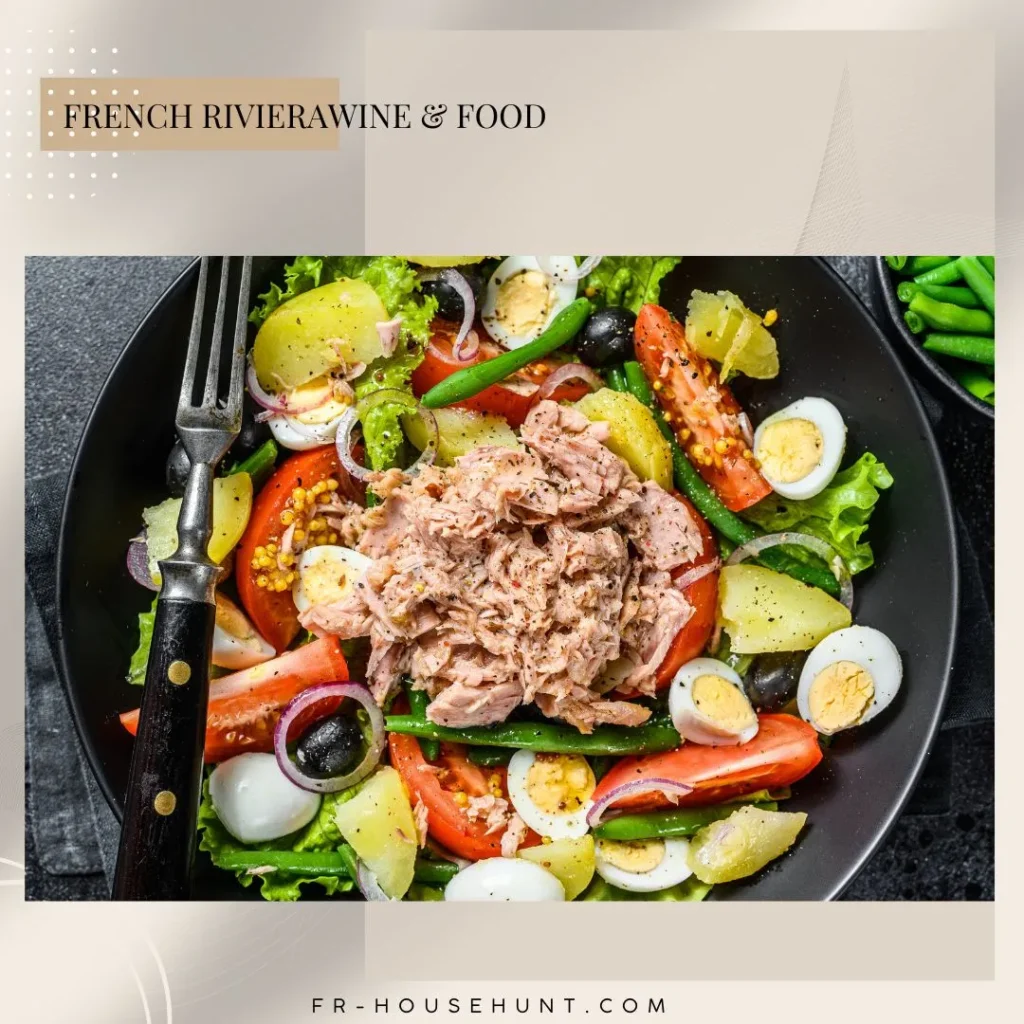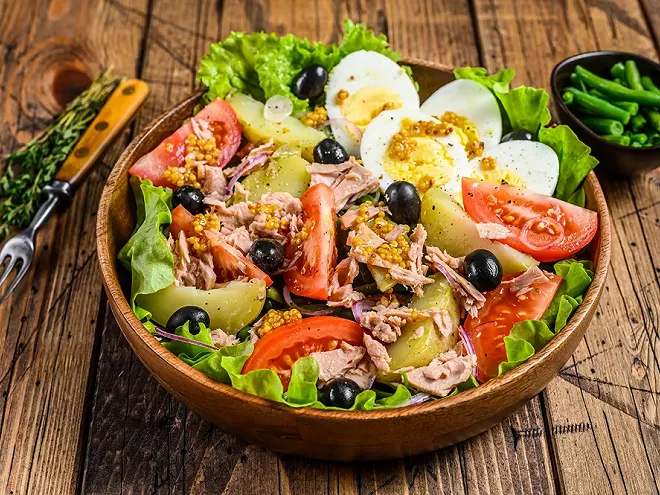
Mini Food & Wine Guide of the French Riviera
How can you do an overview of the art of living on the French Riviera without talking about its gastronomy? It’s impossible! But above all, we are going to try to be very precise, because French Riviera gastronomy, and especially Nice cuisine, has its aficionados, ready to do anything to defend the integrity of the original recipes!
French Riviera cuisine is rich and delicious. Its foundations are olive oil, aromatic herbs, garlic and certain spices.
In this – little – list of French Riviera food are some of the most appetizing specialties of Nice whose mere mention should tickle food-lovers taste buds. This list will certainly not be exhaustive, but it will allow you, at first, not to make a « Parisian » face while browsing the menu of a restaurant, sitting in the sun of the French Riviera:
La salade Niçoise, queen of Nice food.

Mainly composed of raw vegetables (tomatoes, beans, green peppers, artichokes, anchovy fillets, radishes, hard-boiled eggs, olives, salad leaves, etc.). The whole sprinkled with olive oil and a dash of lemon. Be careful, no vinegar!
Les petits farcis.
Small (petit), because they must be prepared with young vegetables. Eggplants, peppers, tomatoes or zucchini flowers are filled with a stuffing whose recipe is kept in the safes of the Société Générale in Nice! This delicious specialty of French Riviera cuisine can also be the highlight of your aperitifs, as it can be eaten on the go.
La bourride.
The bourride is to the Côte d’Azur what bouillabaisse is to Provence. So, is more or less the same thing, but careful, never ask for a bouillabaisse when sitting in a restaurant in the French Riviera. La bourride is rich fish stew made with the catch of the day or several types of fish (white fish like bass, mullet and monkfish) and shellfish, is slowly cooked in a broth laden with saffron, garlic, high-quality olive oil, a brunoise of vegetables, served with garlic croutons, and a good mortar-based aioli.
Experience our tailored Discovery Tours, designed to introduce you to the French Riviera’s unique real estate landscape. Ideal for initial explorers, these tours provide valuable insights into the local market and lifestyle.
Le pan-bagnat.

Among the food of the French Riviera, we cannot fail to mention the pan-bagnat. You may call it a sandwich, but it is a very special one: this typical sandwich from Nice is the only one with a protected designation. It is a special round bread, cut in 2, soaked in olive oil, hence its name meaning « wet bread ». It is then garnished with the same ingredients as the Niçoise salad, but every Niçois thinks he or she has the « real » recipe!
La soupe au pistou.
The pistou soup is a delicious vegetable soup whose ingredients are: green, white and red beans, zucchini, potatoes and tomatoes. The soup is flavored with pistou: a paste made of basil and garlic, crushed in olive oil, and grated parmesan. The pasta is then dipped in it (usually coquillettes). You can’t be considered a full-fledged Niçois if you haven’t tasted this piece of French Riviera food at least once in your life.
La ratatouille.
French Riviera food is healthy and made with fresh, local products. The ratatouille is no exception. It is a healthy, fragrant and economical dish. Its ingredients are full of sunshine and the Mediterranean: zucchini, eggplant, tomatoes and peppers. Purists fry each of these ingredients separately in olive oil. Then, this beautiful little world simmers for a long time in a casserole with garlic and herbs from Provence. An absolute delight!
La merda de can.

We are sure you’re familiar with gnocchi, the homemade pasta from Italy. Throughout its history, and for various reasons, Nice has had dealings with the kingdoms and lordships of the Italian peninsula, and there’s still evidence of this in the food of the French Riviera. One among other, la merda de can (in French merde de chien, in English Dog’s poo, to use an euphemism). This green gnocchi from Nice are made with chard greens, potatoes, flour and eggs. You eat them with melted butter, sage leaves and grated Parmesan cheese.
La socca.
La socca is another exemple of French Riviera food which bears witness to Nice’s centuries-old links with Italy. Called farinata in Italy, this king of hearty pancake-like is made with chickpea flour and enjoyed with a simple a sprinkling of pepper. Perfect with a glass of rosé wine, the socca can make either a light meal or an aperitif highlight. There are also socca crisps – delicious! Our favourite spot for socca is Socca Tram, in Libération district.
French Riviera Wines
The French Riviera is one of the least-known wine producing regions of France. Its production is limited to a few very specific areas. However, the French Riviera has been producing wines since the dawn of time. Or shortly afterwards, with the arrival of the Greeks. Vines arrived here around 600 BC, brought by the Massaliotes (a Greek population who occupied what became the city of Marseille) who built a fortress in Nice. The Romans, masters of the art of wine-making, continued the tradition. Then, during the Middle Ages, Provence, of which Nice was a part until 1388, developed the wine trade.
Let’s take a tour of the vineyards on the French Riviera and the Alpes-Maritimes.
Vignoble de Bellet
It is on the hills to the west of Nice, on narrow plots of land known as ‘restanques’, that the grapes find the ideal conditions to give birth to the wines of Nice.
The Bellet vineyards are located on sun-drenched hillsides, and the appellation area covers 650 hectares at an altitude of around 300 metres. There are around fifteen winegrowers in the Bellet hills, and organic production is widespread. The appellation d’origine contrôlée (A.O.C.) was awarded in 1941. Speaking of grape varieties, Rolle, a typically Mediterranean variety, is the primary grape for the appellation’s white wines (80-90%), along with Chardonnay. Folle Noire and Braquet are used in blends to produce very good reds, rosés, Grenache and Cinsault.
Bellet wine is world-famous: President Thomas Jefferson was a great Bellet wine appraiser.
Vignoble de Saint Jeannet
On the first heights of the French Riviera, you’ll find a little corner of Tuscany at the foot of the Baous de Saint Jeannet. Around 20 centuries ago, the Romans settled on this hillside, a strategic oppidum for controlling the valley. It was they who planted the first vines.
The wines of Saint Jeannet are like no other. Georges Rasse, owner of Domaine des Hautes Collines, tells us the story: ‘My father used to deliver the beautiful bunches of late Saint Jeannet to the hotels by the sea, but it was in 1948 that he embarked on his wine-making adventure’. The originality of these wines lies in the fact that they are kept in bottles for several months on the cellar’s large terraces. Georges Rasse has transformed an empirical approach – ageing in the sun – into a method that works on the oxidation of the wine.
The results are astonishing, with unique aromas of spices and nuts. An amazing result for this wine that goes very well with grilled meats and spicy dishes. This wine goes very well with grilled meats and spicy dishes.
Le Côte de Provence des Alpes-Maritimes, Villar-sur-Var
Nestling high up in a mountainous cirque north of Nice, Clos Saint-Joseph is the only wine-producing estate in the Alpes-Maritimes to benefit from the Côtes de Provence appellation. In the foothills of the Alps, the vines benefit from a wide temperature range, which contributes to the freshness of the wines. They have a mountain profile in Provence. Constance Malangé and Roch Sassi cultivate this small family vineyard, planted mainly with old vines, including a few native varieties such as Grassenc. Ten varieties make up the estate’s three-colour wines, all with strong character. The 5 hectares are cultivated with the greatest respect for tradition. Most of the vines are of a good age, and most of them are native varieties such as Barbaroux.
Les vins des Îles Lérins
Just 15 minutes by boat from Cannes, its Croisette, its Palais des Festival and its legendary beaches, are the Lérins Islands: the Île Sainte-Marguerite, home to the Iron Mask prison, and the smaller, more secretive Île Saint-Honorat. On this island, the Abbaye de Lérins has been home to monk-winegrowers for 16 centuries. The monks cultivate 8 hectares of vines in a geographical and geological context that is quite simply exceptional. Although they don’t claim to have a PDO, the nectars produced by the monks of Lérins, on the island of Saint-Honorat, are certainly worth the diversions. The unique soils, continuous sunshine and influence of the sea produce wines that can be found on the tables of many Michelin-starred chefs. These very rare wines can only be bought on the island or online via the abbey’s website.
In conclusion, French Riviera food and wines are far more than just delicious dishes and drinks; they are an integral part of the region’s rich cultural heritage. Just like the stunning Mediterranean coastline, the picturesque villages, and the historic landmarks, the culinary traditions of the Riviera tell a story of passion, craftsmanship, and a deep connection to the land. From the fresh seafood and fragrant herbs to the world-class rosés and robust reds, every meal is a celebration of the local terroir and the people who cultivate it.
Experience our tailored Discovery Tours!
Let us guide you through the Riviera’s charm and possibilities, setting the foundation for your property journey.
Contact us




